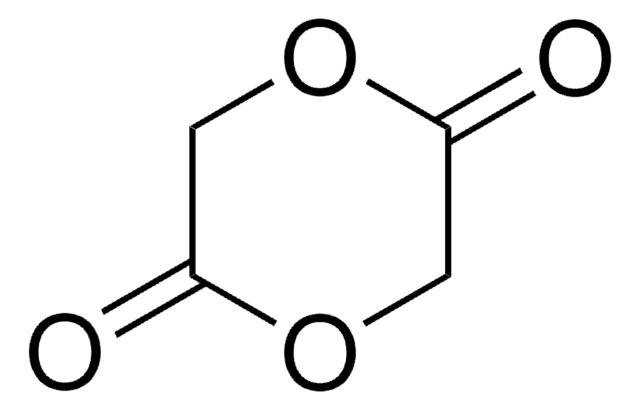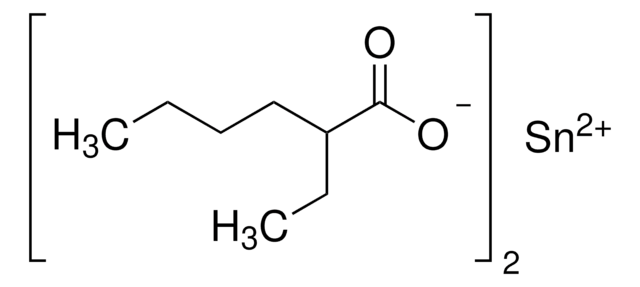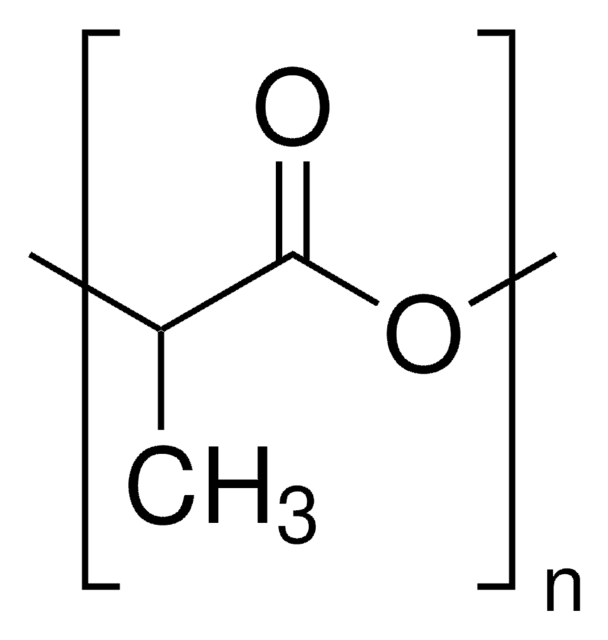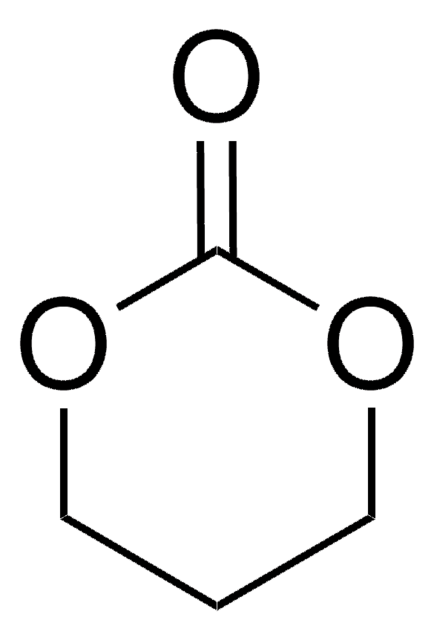Wszystkie zdjęcia(2)
Kluczowe dokumenty
303143
3,6-Dimethyl-1,4-dioxane-2,5-dione
99%
Synonim(y):
DL-Lactide, rac-Lactide, Lactide
Zaloguj sięWyświetlanie cen organizacyjnych i kontraktowych
About This Item
Wzór empiryczny (zapis Hilla):
C6H8O4
Numer CAS:
Masa cząsteczkowa:
144.13
Numer WE:
Numer MDL:
Kod UNSPSC:
12352100
Identyfikator substancji w PubChem:
NACRES:
NA.22
Polecane produkty
Poziom jakości
Próba
99%
Formularz
crystals
bp
142 °C/8 mmHg (lit.)
mp
116-119 °C
grupa funkcyjna
ester
temp. przechowywania
2-8°C
ciąg SMILES
CC1OC(=O)C(C)OC1=O
InChI
1S/C6H8O4/c1-3-5(7)10-4(2)6(8)9-3/h3-4H,1-2H3
Klucz InChI
JJTUDXZGHPGLLC-UHFFFAOYSA-N
Szukasz podobnych produktów? Odwiedź Przewodnik dotyczący porównywania produktów
Powiązane kategorie
Opis ogólny
3,6-Dimethyl-1,4-dioxane-2,5-dione (or rac-lactide), is the 50:50 racemic mixture of D- and L-Lactide. Rac-lactide is a lactone derived from lactic acid that has attracted great interest in academia and commercial applications, as it is derived from abundant renewable resources. Rac-lactide can be ready polymerized via ring-opening polymerization, using a variety of metal or organocatalysts, yielding poly(D,L-lactide). While the resulting polymer is generally amorphous, the use of stereospecific catalysts can lead to heterotactic PLA, which exhibits some degree of crystallinity.
Zastosowanie
3,6-Dimethyl-1,4-dioxane-2,5-dione can be used as a reactant:
- To synthesize multi-block copolymers of polylactide and polycarbonate.
- In the aluminum-catalyzed polymerization of propene oxide, lactide, and phthalic anhydride to produce multi-block polyesters.
Ta strona może zawierać tekst przetłumaczony maszynowo.
Hasło ostrzegawcze
Warning
Zwroty wskazujące rodzaj zagrożenia
Zwroty wskazujące środki ostrożności
Klasyfikacja zagrożeń
Eye Irrit. 2
Kod klasy składowania
11 - Combustible Solids
Klasa zagrożenia wodnego (WGK)
WGK 2
Temperatura zapłonu (°F)
Not applicable
Temperatura zapłonu (°C)
Not applicable
Środki ochrony indywidualnej
dust mask type N95 (US), Eyeshields, Gloves
Wybierz jedną z najnowszych wersji:
Masz już ten produkt?
Dokumenty związane z niedawno zakupionymi produktami zostały zamieszczone w Bibliotece dokumentów.
Klienci oglądali również te produkty
Insun Yu et al.
Journal of the American Chemical Society, 134(30), 12758-12773 (2012-07-07)
A family of racemic and enantiopure indium complexes 1-11 bearing bulky chiral diaminoaryloxy ligands, H(NNO(R)), were synthesized and fully characterized. Investigation of both the mono- and the bis-alkoxy-bridged complexes [(NNO(R))InX](2)[μ-Y][μ-OEt] (5, R = (t)Bu, X = Y = Cl; 8
Kimberly M Osten et al.
Dalton transactions (Cambridge, England : 2003), 41(26), 8123-8134 (2012-04-07)
Functionalized diaminophenols, H(N(R1R2)N(R3)O), were investigated as ligands for indium catalysts in the ring-opening polymerization of racemic lactide. Precursor complexes (N(Me2)N(Me)O)InCl(2) (1), (N(Pr2)NO)InCl(2) (2), and (N(Mes)NO)InCl(2) (3) were synthesized and fully characterized by (1)H and (13)C NMR spectroscopy, elemental analysis, and
Vibrational Optical Activity of (3 S, 6 S)-3, 6-Dimethyl-1, 4-dioxane-2, 5-dione.
Tam CN, et al.
Journal of the American Chemical Society, 118(42), 10285-10293 (1996)
Fabio Marchetti et al.
Dalton transactions (Cambridge, England : 2003), 42(8), 2792-2802 (2012-09-11)
A series of group 4 metal tetracarbamates M(O(2)CNR(2))(4) (M = Ti, R = Et, 1a; M = Zr, R = Et, 1b; (i)Pr, 1c; M = Hf, R = Et, 1d; R = (i)Pr, 1e) were studied as catalytic precursors
Lu Qin et al.
Dalton transactions (Cambridge, England : 2003), 48(32), 12315-12325 (2019-07-26)
In this paper we report a series of Al(iii) complexes supported by N,O-bidentate β-pyrazyl functionalized enolate ligands HL1-HL5 (L = (6-Me-2,5-C4H2N2)-CH[double bond, length as m-dash]C(R)-O-), (R = tBu, Ph, p-tolyl, p-OMePh, o-tolyl) and their exploitation for the ring-opening polymerization of
Global Trade Item Number
| SKU | GTIN |
|---|---|
| 303143-25G | 4061826666241 |
| 303143-100G | 4061835052257 |
| 303143-10KG | |
| 303143-1KG |
Nasz zespół naukowców ma doświadczenie we wszystkich obszarach badań, w tym w naukach przyrodniczych, materiałoznawstwie, syntezie chemicznej, chromatografii, analityce i wielu innych dziedzinach.
Skontaktuj się z zespołem ds. pomocy technicznej















